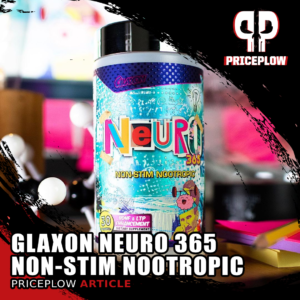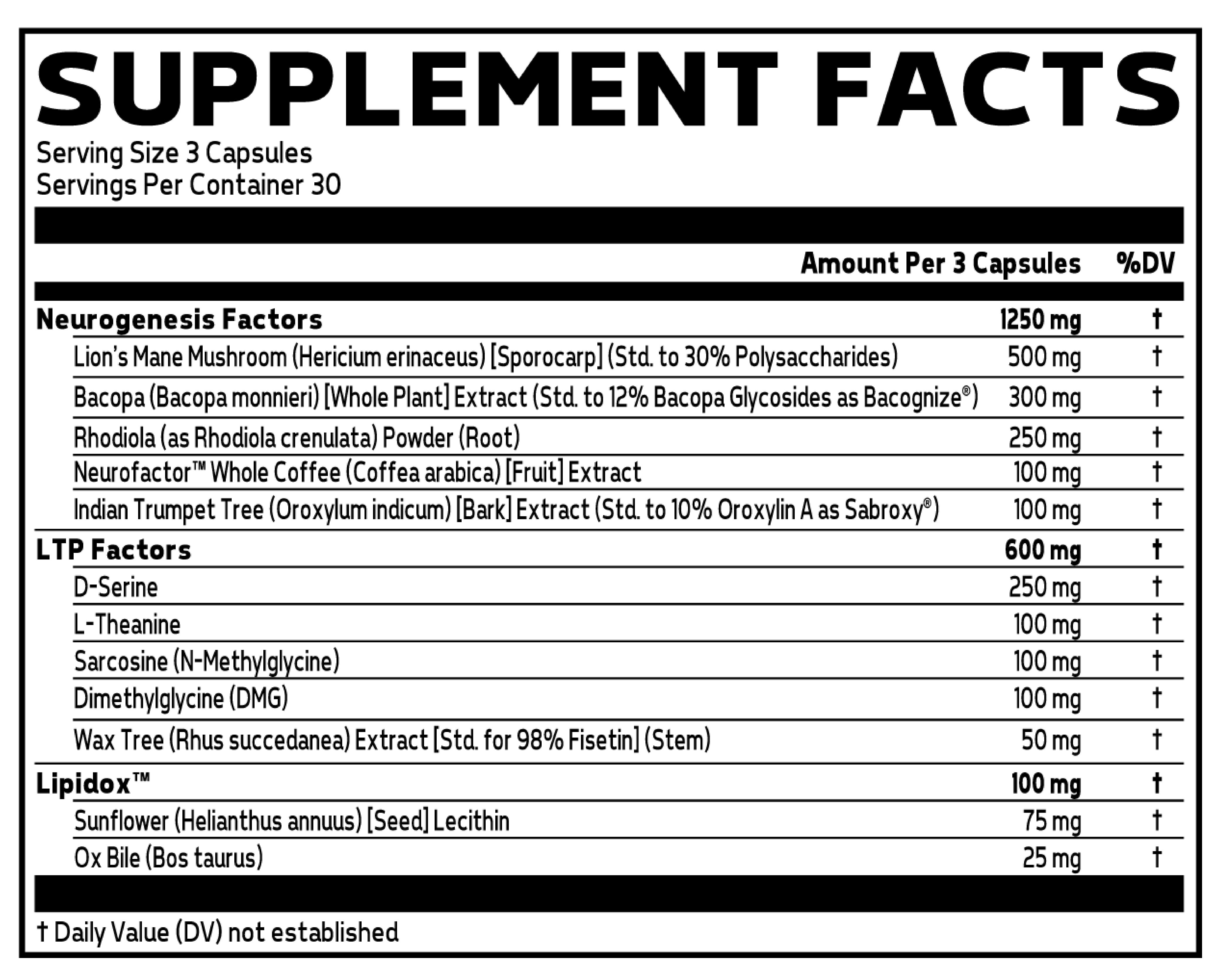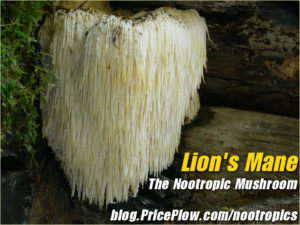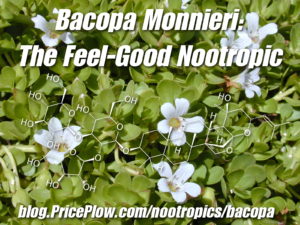The name Glaxon is quickly becoming one of the supplement industry's watchwords for innovation, thanks to the science team's commitment to staying abreast of cutting edge research and also being first to find subtle, yet powerful, tweaks that optimize extraordinarily popular formulas. Any astute observer of the industry would do well to study Glaxon's products as a harbinger of coming trends.

A non-stimulant nootropic that supports BDNF and LTP, Glaxon Neuro 365 is an excellent brain booster built differently.
Today we're going to talk about Glaxon's Neuro 365, a stimulant-free nootropic supplement that's designed to improve cognition by targeting two fundamental mechanisms in the brain: brain-derived neurotrophic factor (BDNF) production and long-term potentiation (LTP).
A stim-free nootropic that stacks
One of the things we love about Glaxon is the modularity of their supplement line: different products with the same focus are formulated to complement each other, so that you can stack them for a nice synergistic effect. When it comes to Neuro 365, Glaxon recommends combining it with their other nootropic supplement, Glaxon Goon Mode, which is designed with gamers in mind.
The story and science are below, but first you can check PricePlow's coupon-powered prices and sign up for our Glaxon news, since they're not even close to done with this season's launch schedule:
Glaxon Neuro 365 – Deals and Price Drop Alerts
Get Price Alerts
No spam, no scams.
Disclosure: PricePlow relies on pricing from stores with which we have a business relationship. We work hard to keep pricing current, but you may find a better offer.
Posts are sponsored in part by the retailers and/or brands listed on this page.
Ingredients
In three capsules, taken daily (365 / year round!), you get the following novel formula:
-
Lion's Mane Mushroom (Hericium erinaceus) [Sporocarp] (std. to 30% Polysaccharides) - 500 mg
As a stimulant-free nootropic, Neuro 365 still packs a lot of experience, thanks to its LTP and BDNF boost matrices
Also known as Hericium erinaceus, lion's mane mushroom has been used for thousands of years across Asia, as both medicine and food.[1] Because of cutting-edge scientific research attesting to the profound cognitive benefits of the mushroom, its use has exploded in recent years. We think this is a great trend, because whether in supplement or extract-form, lion's mane is truly awesome for brain health.
Beta-glucans: "Brain fertilizer"
The number of bioactive compounds in lion's mane, as with most mushrooms, are too numerous for us to discuss all of them here. The ones you really have to know about— those that make lion's mane special— are the beta-glucans, psychoactive polysaccharides[1] that have a direct effect on the brain.
Lion's Mane: Cognitive enhancer and neuroprotector
The beta-glucans in lion's mane can inhibit the action of an enzyme called acetylcholinesterase,[2] which is responsible for breaking down acetylcholine in the body. We at PricePlow often refer to acetylcholine as "the learning neurotransmitter" because of its central role in the formation of memories. And generally speaking, anything that increases the levels or action of acetylcholine in the body is going to improve cognition. High levels of acetylcholine are crucial for overall brain function.
Lion's Mane is an incredible mushroom that touts some extremely unique nootropic benefits including increasing Nerve Growth Factor.
The benefits of lion's mane go far beyond its effect on the acetylcholine system, though. eta-glucans in the mushroom also upregulate the expression of a protein called nerve growth factor (NGF),[3] which helps regulate the function of the cholinergic system. Also NGF contributes to overall neural health[3] by stimulating the growth of new neurons and dendrites,[4] the connections between neurons.
If you're interested in a more detailed look at lion's mane and what it does, read our long-form article: Lion's Mane: The Nerve Growth Nootropic Mushroom
-
Bacopa (Bacopa Monnieri) [Whole Plant] Extract (Std. to 12% Bacopa Glycosides as Bacognize) – 300 mg
Bacopa monnieri is another ancient herb. Its use goes all the way back to the practice of Ayurvedic medicine in ancient India where it was used to improve memory and treat epileptic seizures.
According to the latest theories, the cognitive benefits of Bacopa supplementation come from its bacosides,[5] a class of saponins that are somewhat similar in structure to polysaccharides, like the beta-glucans we discussed in the previous section.
Bacopa is a perennial flowering plant frequently used for its mood-enhancing qualities, but it's also an incredibly powerful nootropic for learning and memory
In one 2011 study, mice given Bacopa were better at learning and memorizing, and upon closer examination, were found to have a greater number and length of dendrites in their brains compared to controls.[6] In other words, Bacopa's effect on the structure of the brain resembles that of lion's mane.
Animal models can be useful, but we want to look at human studies whenever possible. Luckily for us, there was a study in 2001 in which human subjects were given 300 milligrams of Bacopa (note that it's the same dose used in this product) or a placebo. After three months, the Bacopa group had faster visual processing and learning, and better memory retention, compared to the placebo group.[7]
Is there a mechanism that can give a unified explanation for all these different effects? A research review on Bacopa from 2015 concludes there might be: the authors of that review found that in virtually every study on the plant, researchers cited the ability of Bacopa to protect the brain from oxidative stress by reducing free radicals,[8] which can help prevent a decline in cognitive function.
Given the close connection between the brain and the mind, it's probably not surprising to hear that Bacopa seems to have positive effects on mental health as well. By reducing cortisol levels, Bacopa supplementation can improve mood and reduce the perception of stress.[9]
-
Rhodiola (as Rhodiola crenulata) Powder (Root) - 250 mg
One of the many things we at PricePlow appreciate about Glaxon is their incredible attention to detail and their willingness to innovate, even if it means making subtle tweaks, to optimize a formula. Their selection of Rhodiola crenulata is a perfect illustration of that diligence: although Rhodiola rosea is the species of Rhodiola that's more popular with supplement manufacturers, there's a lesser-known variant, Rhodiola crenulata, that actually has higher phenolic content and antioxidant activity.[10]
Rhodiola: Our favorite feel-good herb with some additional workout boosting properties, thanks to the salidroside inside. Image courtesy Wikimedia
Plants of the Rhodiola genus have long been recognized for their activity as adaptogens, a class of compounds that help regulate and normalize our bodies' stress responses. Rhodiola, in particular, helps to regulate the serotonin system,[11] and current research suggests it can improve the mood states of people who take it.[12] Besides improving overall mood, extracts of Rhodiola have been shown to significantly reduce measures of anxiety, stress, and anger.[13]
As a nootropic, Rhodiola helps promote long-term potentiation (LTP) in the hippocampus, which facilitates the consolidation of short-term memories into long-term memories.[14] Subjects given Rhodiola extracts have also shown fewer signs of confusion than controls.[13]
Rhodiola also seems to reduce mental and physical fatigue at a variety of doses, ranging from 100 milligrams[15] to more than 500 milligrams[16] of root extract.
One thing to keep in mind when taking Rhodiola is that it functions as a monoamine-oxidase (MAO) inhibitor[17,18] and shouldn't be taken with certain drugs, such as selective serotonin reuptake inhibitors (SSRIs). When in doubt, ask your doctor about potential drug interactions with Rhodiola.
-
NeuroFactor Whole Coffee Fruit Extract - 100 mg
NeuroFactor is a standardized extract of coffeeberry that is used to improve focus and cognition.
It does this by upregulating a protein we discussed earlier, BDNF, which improves learning and memory by supporting the growth, survival, and maintenance of neurons in certain regions of the brain.[19]
Researchers have established a positive correlation between BDNF levels and cognitive function.[20] Higher levels of BDNF may protect against various neurotoxins and disorders of the brain.[20,21]
Conversely, low levels of BDNF appears to increase one's risk for neurodegenerative illnesses.[21]
In research settings, a 100 milligram dose has been shown to increase BDNF levels by nearly 150%.[21]
-
Indian Trumpet Tree (Oroxylum indicum) [Bark] (Std. to 10% Oroxylin A as Sabroxy) - 100 mg
One of the two big themes behind Neuro 365 is long-term potentiation (LTP), which we discussed above. Just to recap, LTP is basically how short-term memories become long-term memories, and Glaxon has formulated Neuro 365 to support this process.
That's where the trademarked Sabroxy extract of the Indian trumpet tree comes in. It's standardized to contain a minimum of 10% oroxylin A, a flavone found in many medicinal plants that has been shown to raise BDNF levels and facilitate LTP in mice.[22]
There is also some compelling evidence that due to its effect on BDNF production, oroxylin A can increase the rate at which new neurons grow in the hippocampus of adult rats.[23] This process of neuronal growth, called neurogenesis, is probably why oroxylin A has been shown to improve cognitive function in animals.[23]
In one experiment on mice, oroxylin A was shown to protect their brains against damage caused by insufficient blood flow.[24]
-
Long-Term Potentiation (LTP) Factors - 600 mg
What the ingredients in this blend have in common is their effect on the NMDA receptor, whose action is crucial for the process of long-term potentiation.
To give you an idea of what that means,
Team Red or Team Blue? Glaxon Goon Mode is a gaming supplement with a very flexible dosing schedule, at just 62.5mg caffeine per scoop!
-
D-serine deficiency has been linked to NMDA receptor inhibition and impaired LTP.[25]
-
In rats, L-theanine prevents the impairment of long-term potentiation by stress,[25] and can help reverse the impairment of LTP in mice with Alzheimer's disease.[26]
-
Sarcosine (also known as N-Methylglycine), by activating NMDA receptors, can also improve LTP.[27]
-
Dimethylglycine (DMG) can help restore NMDA receptor function (and hence LTP) in rodents that have been repeatedly exposed to toluene[28] and ketamine.[29]
-
The fisetin provided by Wax Tree (Rhus succedanea) is a senolytic antioxidant flavonoid that has neurotrophic and anti-inflammatory effects.[30] It promotes neurite growth, enhances long-term memory, and is neuroprotective through numerous mechanisms, such as inducing ERK1/2 activation as well as PC12 cell differentiation.[31]
You may also recognize L-Theanine from the numerous supplements that utilize it alongside caffeine, where it synergizes. Although Neuro 365 is caffeine-free, the theanine in there can help reduce any jitters and promote better cognition and smooth focus if you were to pair it with a caffeinated drink such as coffee.
-
-
Lipidox - 100 mg
Composed of sunflower lecithin and ox bile, this little blend is designed to maximize the absorption of the other ingredients. Lecithins of all kinds are famous for their emulsifying properties, and can help with the digestion and absorption of fat-soluble nutrients. Ox bile, when taken as an oral supplement, can help stimulate the human body's production of bile, and hence improve overall digestion.[32]
Conclusion
Neuro 365 from Glaxon takes an elegant approach to cognitive enhancement by drilling down to a couple of fundamental cognitive processes and then supporting those processes from a variety of angles, simultaneously. The fact that it's caffeine-free means it's easy to incorporate into your current diet and lifestyle -- no need to choose between getting too much caffeine overall or giving up your delicious morning cup of coffee.
And if you haven't figured it out by looking at the name, Neuro 365 is built to be taken every day - no cycling needed!
Glaxon Neuro 365 – Deals and Price Drop Alerts
Get Price Alerts
No spam, no scams.
Disclosure: PricePlow relies on pricing from stores with which we have a business relationship. We work hard to keep pricing current, but you may find a better offer.
Posts are sponsored in part by the retailers and/or brands listed on this page.










Comments and Discussion (Powered by the PricePlow Forum)